Speckled eggs are a beautiful sight to see. They are a common sight on the ground around homes and gardens, but what are they?
Some people believe that speckled eggs indicate a healthier bird because it means that the bird is getting enough nutrients. Other people think that the speckles are just cool and add to the appeal of the eggs.
In the article below we’ll look at different types of bird eggs, how to identify them, when they are laid and more.
Birds that lay speckled eggs
1. European herring gull

Size: 24 to 26 inches (60-67cm)
Wingspan: 49 to 60 inches
Weight: 1.57 – 2.43 lbs
European herring gulls or the Larus argentatus are large gulls that breed in northern Europe and Asia. It is migratory, wintering in southern Europe and Australasia.
This gull is a medium-sized bird with a white body, grey back and wings, and stunning yellow eyes. Note the red spot on the yellow bill. Legs are pinkish-grey.
European herring gulls feed on fish, insects and other small animals. They typically nest in colonies on cliffs or coastal islands. The olive-brown speckled legs are laid between April and June.
Incubation period lasts up to 30 days. Chicks are taken care of by both parents.
2. Winter wren

Size: 3.1 – 4.7 inches (8 to 12cm)
Wingspan: 4.7 – 6.3 inches
Weight: 0.3 – 0.4 oz
What birds lay red speckled egg? Winter wrens. Small and plump, these birds are resident breeders in evergreen forests of Western North America. This bird is brown with faint barring on the belly and wings. Take note of its short tail.
Unlike other birds, they build dome-shaped nests. Males take up the task of building the nests, a few each season, while the females line them with feathers. They place them at least 23 – 25 feet above ground.
Egg laying happens in April. Each female lays 1-9 eggs. Winter wrens’ eggs are about 0.6 to 0.8 inches in length. Note the reddish-brown spots are concentrated on one side of the egg.
The winter wren is active during the day and often sings loudly. It feeds on insects and spiders and builds a nest of moss, lichen, and grasses.
3. Great tit
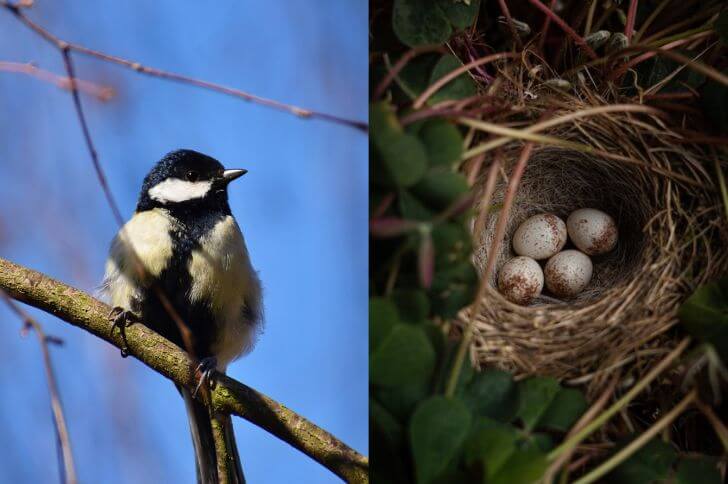
Size: 4.9-5.5 inches (12.5 to 14 cm)
Wingspan: 8.7 – 10 inches
Weight: 0.5 – 0.8 oz
Great tits or the Parus major are small passerine birds that are found across Europe and Asia. This species is easily identified by its distinctive black head and neck, white cheeks, a broad stripe that runs from its bib to its vent, and overall lemon-yellow color. Juveniles are duller.
Great tits are a sociable bird that typically nests in loose colonies, and are known to form close bonds with other members of its flock.
This species is a monogamous breeder. Breeding season starts from January-September. These small birds lay as many as 18 spotted eggs that only females incubate. This species feeds on a variety of items, including insects, spiders, seeds, and fruit.
4. Melodious Warblers

Size: 4.7 – 5.1 inches
Wingspan: 5.7 inches
Weight: 0.5 oz
What kind of bird lays pink speckled eggs? Melodious warblers.
Where can you see melodious warblers? In parts of Europe and Africa. These little birds are around 4 inches long and have beautiful yellow hue below and olive brown upperparts. They can often be heard singing from high in the trees as they travel.
They build their nests on rocks and trees close to water sources. The pink spotted egg of the melodious warbler is pinkish with brown spots. The speckles are evenly spread on all sides.
5. Song thrush
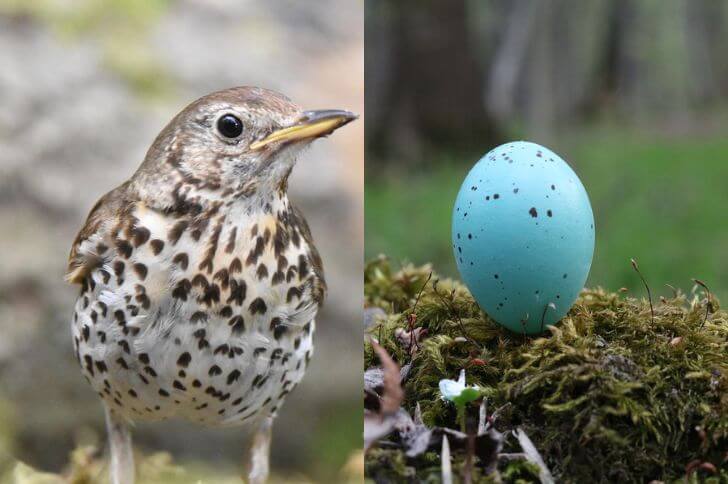
Size: 9.0 inches
Wingspan: 13.0 – 14.2 inches
Weight: 2.3 – 3.5 oz
What bird lays blue speckled eggs? Song thrush.
The song thrush is a common bird found in Europe and parts of Australia. They are usually around 9 inches in length and have a brown back and a whitish spotted belly. The males are known for their beautiful song, which is often used to mark their territory.
During nesting season, the female weaves a dry grass and mud nest where she later lays 3-5 blue spotted eggs. Like other mottled eggs on this list the speckles are concentrated on the larger side of the eggs.
Eggs hatch after 2 weeks and fledgling occurs after 14 days. They feed on insects, berries, and other small prey. These birds are considered to be very territorial and will often attack other animals or people who come too close to their nest.
6. California gull
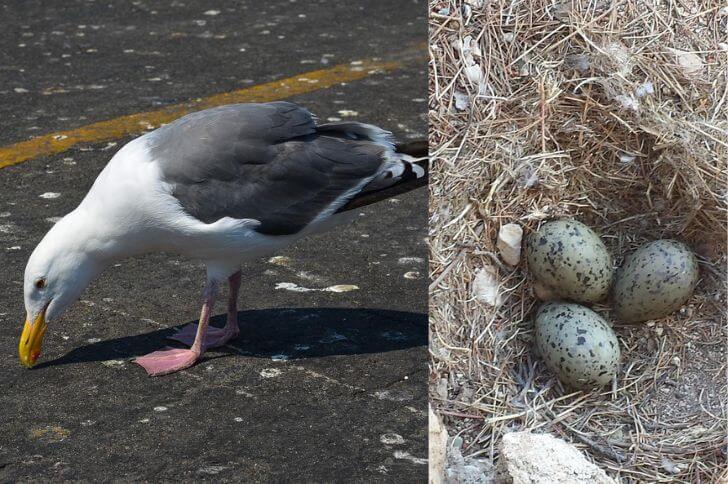
Size: 18.5-21.3 inches (47 to 54cm)
Wingspan: 51.2 inches (130cm)
Weight: 15.0-36.9 oz
California gulls are large, white gulls that breed in western North America. They are one of the most common gulls in the coastal areas of California, Utah and Oregon. The California gull is also found in inland areas, such as the Great Lakes region and the Mississippi River valley.
How can you identify the California gull egg? Be on the lookout for nests on the ground that are made of grass, feathers and bones. The eggs will be greenish with dark splotches and speckles.
The two to three eggs are about 2.5-2.7 inches and take about 27 days to hatch.
This gull is adaptable and can be found in a variety of habitats, including open fields, estuaries, and garbage dumps. It feeds on a wide range of food items, including insects, fish, rodents, and discarded human food.
7. Northern Mockingbird

Size: 8.3-10.2 inches (21-26cm)
Wings: 12.2-13.8 inches (31-35cm)
Weight: 1.6-2.0 oz
Northern Mockingbirds are common residents in most of our backyards. These birds can be found in almost any habitat, including gardens, forests, and even cities.
At about 1 year, northern mockingbirds are old enough to start mating. They breed in Spring to early summer. Their clutch includes 2-6 green speckled eggs. Incubation lasts for 13 days.
The Northern Mockingbird is known for its beautiful song, which it sings from high in a tree. These birds are also known for their intelligence; they can learn to recognize the sounds of different predators and warn other birds of danger.
The Northern Mockingbird is a versatile bird that feeds on a variety of insects, berries, and seeds. It is also known to scavenge for food near people or pets, making it one of the few birds that will eat from a bird feeder.
8. Varied thrush

Size: 7.5-10.2 inches (19 to 26cm)
Wings: 13.4-15.0 inches (34-38cm)
Weight: 2.3-3.2 oz
Varied thrush is a medium-sized songbird that is found in North America and parts of Europe. It has a dark gray back, dark breastband, cap and mask, and a rich orange on the rest of the body. Females are browner.
Females are in charge of selecting where to place cup-shaped nests. Their clutch is about 2-6 eggs that are blue with brown speckles. Parent birds take turns in caring for young thrush.
This mid-sized bird is known for its beautiful song, which can be heard throughout the year. This bird is also known for its excellent camouflage; it can blend in with the surrounding environment very well. The varied thrush feeds on insects, fruit, and seeds.
9. House finch

Size: 5.1-5.5 inches (13-14cm)
Wings: 7.9-9.8 inches (20-25cm)
Weight: 0.6-0.9 oz
The house finch or the Haemorhous mexicanus is a small passerine bird. The body size of a house finch ranges from 5.1-5.5 inches. They have brown streaked upperparts and a reddish head and chest. Female house finches are slightly duller than the males, with no red on their chest.
Pairing starts in winter and during courtship you’ll notice the male gently touching the female’s bill. These birds nest in conifer-deciduous forests or tall buildings, weaving nests from various materials.
House finch eggs range from white to pale blue with black speckles. Chicks hatch after 2 weeks.
House finches forage on the ground or in trees, where they mainly eat seeds and berries. They can be found throughout North America, Central America, and parts of South America.
10. California quail

Size: 9.4-10.6 inches (24-27cm)
Wings: 12.6-14.6 inches (32-37cm)
Weight: 4.9-8.1 oz
California quails are plump, sprightly birds that are common in the Southwest. They have black and white mottled belly, gray-brown back, and characteristic topknot of feathers.
How can I identify the egg of the California quail? Like other quail birds, this species also hides its nests so it might be a bit difficult to come across their eggs. And, their eggs are typically creamy white with brown splotches. They are about 1.3 inches in length, slightly larger than warbler eggs.
These birds are omnivorous, eating seeds, insects, and other small creatures. They are often found near water sources, where they can drink and bathe.
11. Mistle thrush
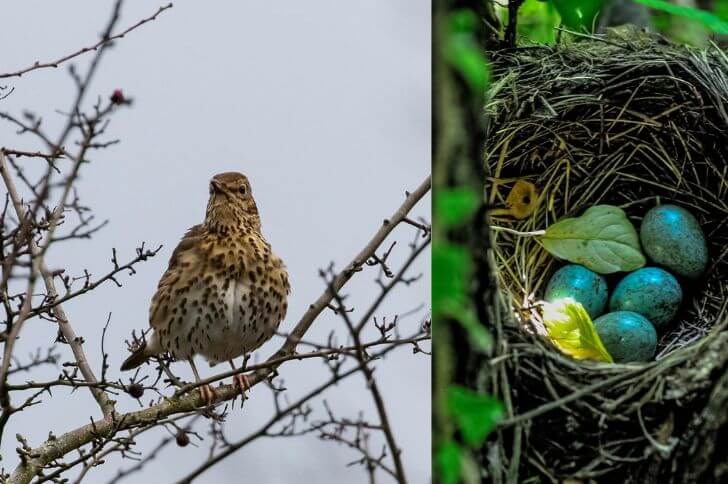
Size: 11-11.5 inches (27-28cm)
Wings: 18 inches
Weight: 3.3-5.9 oz
The mistle thrush is a migratory bird that breeds in Europe and Asia. Why is it caled a mistle thrush? Because it prefers fruits from the mistletoe tree.
What do thrush eggs look like? Mistle thrush eggs are glossy and smooth. They are pale blue with a few large dark speckles.
Where do thrush lay eggs? This mid-size bird species builds its nest on forked branches. Their clutch, typically of 2-5 eggs, takes up to 15 days to hatch.
Mistle thrushes eat insects, berries, seeds, and fruit. They are aggressive during breeding.
12. White wagtail
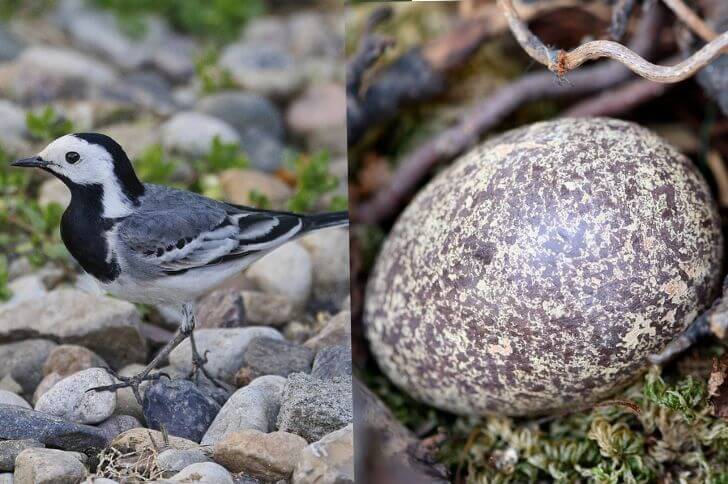
Size: 6.5-7.5 inches (16.5-19.5 cm)
Wings: 9.8- 11.8 inches
Weight: 0.88 oz
White wagtails are another group of birds that lay spotted eggs. This small passerine bird is from the family motacillidae which also includes longclaws and pipits. It breeds in Europe and Asia, and is a long-distance migrant, wintering in Africa.
Their eggs look whitish or grayish with fine brown spots. They need about 2 weeks of incubation and leave the bird’s nests at 2 weeks.
This species has a brown-gray back, black and white head and a long tail. It is similar to the pied wagtail, but is paler and has a shorter tail.
White wagtails forage in open areas near water, picking up insects from the ground.
13. Meadow pipit
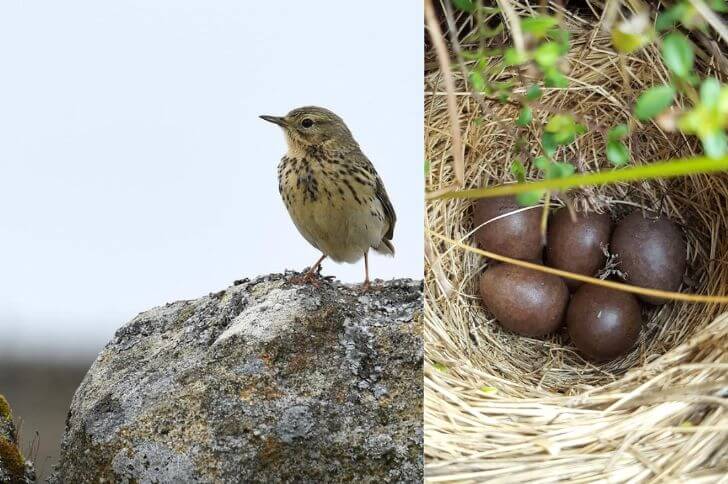
Source: bitheolaidhe
Size: 5.7 – 5.9 inches (14.5-15cm)
Wings: 8.7-9.8 inches
Weight: 0.5 – 0.7 oz
Meadow pipits are small passerine birds in the long claw and wagtail family. The adults are brown and heavily streaked while immature pipits are duller.
Their oval eggs are cream colored with heavy red brown freckles. They have two weeks.
These pipits are common in Europe and Asia. They breed in open habitats such as fields, meadows, tundra, and marshes. Pipits are ground nesters, weaving cup-like nests out of grass and other materials.
14. Common cuckoo

Size: 13 inches (34 cm)
Wings: 22-24 inches (55-60cm)
Now to what I believe is the most interesting bird on this list, the common cuckoo. It is from the same family as roadrunners and ani birds.
What makes a common cuckoo unique? They are brood parasites. This bird species are notorious cheats, making other birds do all the heavy-lifting for them.
Common cuckoos are known to go into other birds nests’, lay their eggs, and let other birds take care of their young. They prefer nests of other birds that lay similar shaped and colored eggs, mostly pied wagtails and European robins.
Scientists have been amazed by the cuckoo eggs and babies’ evolution,overtime, enough to fool hosts bird species and prevent rejection. The common cuckoo is a migratory bird, breeding in Europe and Asia and wintering in Africa.
15. House wren

Size: 4.3-5.1 inches (11-13cm)
Wings: 5.9 inches (15cm)
Weight: 0.3-0.5 oz
Seen a small brown bird in your backyard? House wrens are one of the most common birds in North America. They can be found in every state, and they’re even common in Canada. They’re so common that many people don’t even notice their presence.
In the wild, house wrens prefer nesting in tree cavities, mostly abandoned woodpecker holes. In backyards, put a few nest boxes. Their eggs come in different colors depending on the region. You can spot small, 0.6-0.8-inch, pink-white eggs, grayish or white eggs. The slightly glossy have brown speckles or blotches.
These small birds are very active and they can be seen hopping around on the ground or climbing up trees.
Also read: Learn about roadrunner eggs and babies
16. Great Bustard

Sources: greatbustard.org
Size: 3ft 9 inches
Wings: 6ft 11 inches
Weight: up to 40 lb
One of the largest birds that lay speckled eggs are the great bustards. A mature male can be 46 pounds with huge wings measuring to 6 feet.
How big are the great bustard eggs? They can weigh up to 5.3 oz and are about 3.3 inches long, making them one of the largest eggs in the bird world. Eggs are cream with brown blotches.
Females take care of the eggs for about 4 weeks and the young ones will stay with their mom for about one year.
Great bustards are large, ground-dwelling birds of the bustard family. The species is endemic to some parts of Europe where it inhabits open grassland and arid scrubland. Bustards are omnivorous and feed on a variety of things. They are usually solitary birds, but may form small groups during the breeding season.
17. Common redpoll
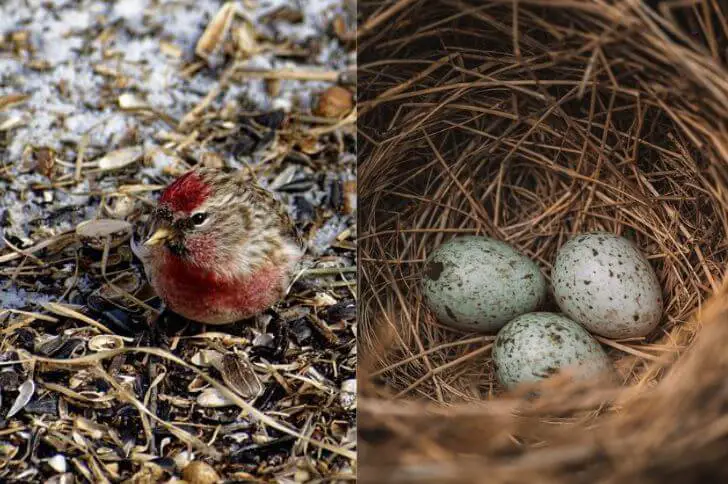
Size: 4.7-5.5 inches (12-14cm)
Wings: 7.5-8.7 inches (19-22cm)
Weight: 0.4-0.7 oz
The common redpoll or the Acanthis flammea is a small passerine bird in the finch family. It is found in shrubs and thickets across North America and Europe. This bird is reddish brown bird with a red cap. Females are a streaky brown with a red patch on their heads.
They lay 2-5 green blue eggs with purplish speckling or reddish brown streaks.
The common redpoll eats seeds from plants such as alder, birch, grasses, or weed seeds. It will also eat insects on occasion.
18. Gray headed swamphen

Size: 15-19.7 inches (38-50cm)
Wings: 35.4-39.4 inches (90-100cm)
Weight: 17.8-30 oz
Gray-headed swamphens or the Porphyrio poliocephalus are large, chicken-sized water birds that breed in wetlands in Southeastern Florida and parts of Asia. This species has a gray head, heavy red bill and eyes, and a purple blue body. The sexes are similar, but juveniles are paler with dull eggs.
What about their nesting habits? They measure about 1.3-1.5 inches and are tan-colored with brown speckles. Incubation period lasts about 26 days.
Gray-headed swamphens are omnivorous, eating aquatic plants, seeds, small invertebrates and frogs. It forages by wading in shallow water or walking overland, sometimes probing into the mud for food. This bird is usually seen alone or in pairs, but sometimes forms large flocks near water.
Hi, my name is Steve. My friend and I started the spanishbirdguides.com to share our passion with other like-minded people. So, if bird watching is your thing, you’ll love this blog. I’ll share what I’ve learnt about both local birds and those found in other parts of the world. Also, I’d love to hear your experiences.



